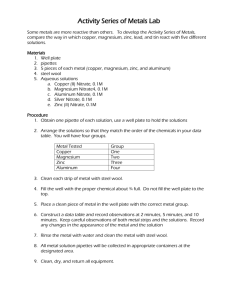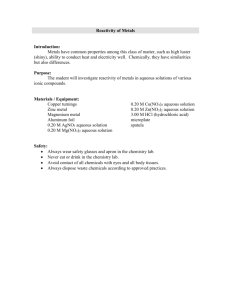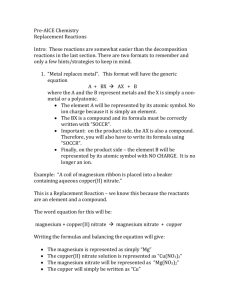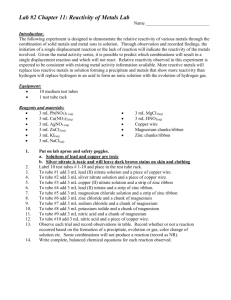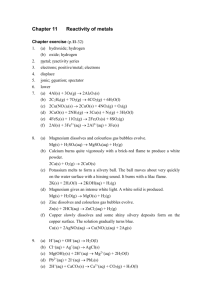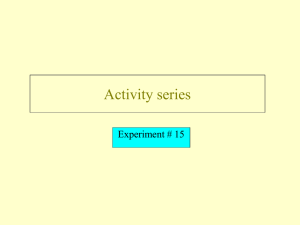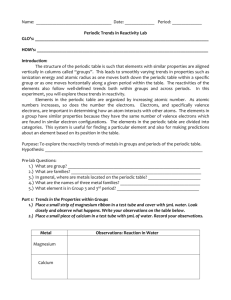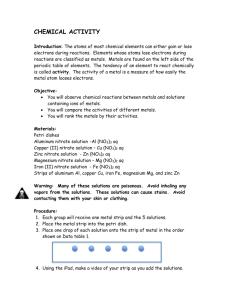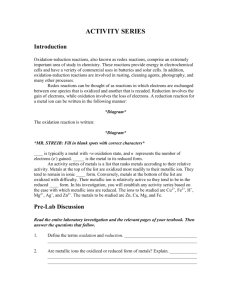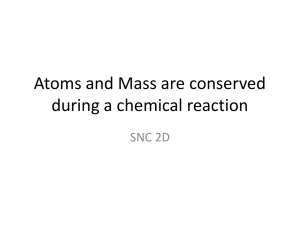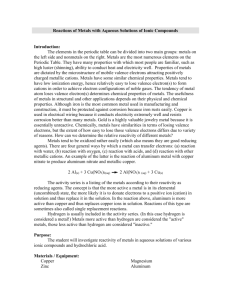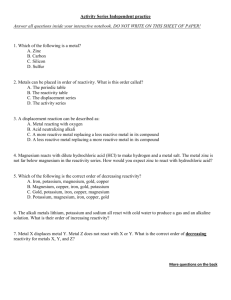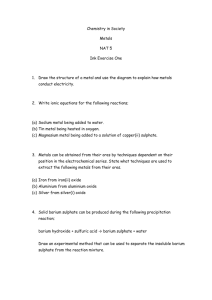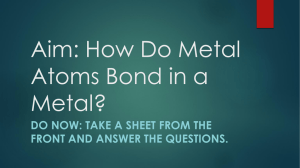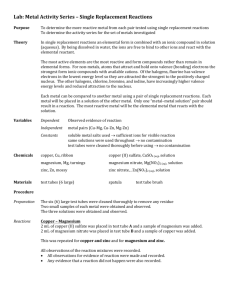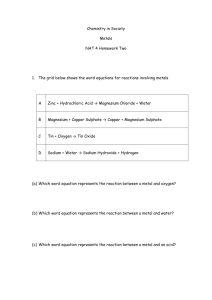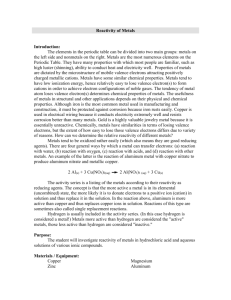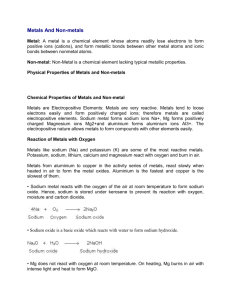Reactivity of Metals Lab
advertisement
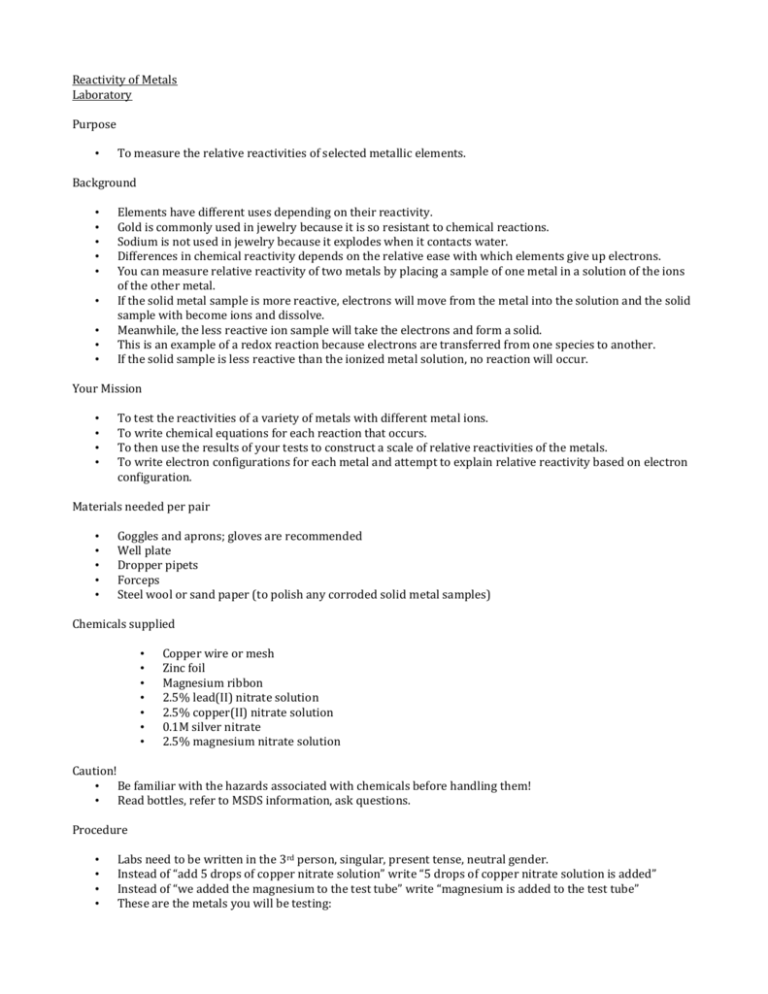
Reactivity of Metals Laboratory Purpose • To measure the relative reactivities of selected metallic elements. Background • • • • • • • • • Elements have different uses depending on their reactivity. Gold is commonly used in jewelry because it is so resistant to chemical reactions. Sodium is not used in jewelry because it explodes when it contacts water. Differences in chemical reactivity depends on the relative ease with which elements give up electrons. You can measure relative reactivity of two metals by placing a sample of one metal in a solution of the ions of the other metal. If the solid metal sample is more reactive, electrons will move from the metal into the solution and the solid sample with become ions and dissolve. Meanwhile, the less reactive ion sample will take the electrons and form a solid. This is an example of a redox reaction because electrons are transferred from one species to another. If the solid sample is less reactive than the ionized metal solution, no reaction will occur. Your Mission • • • • To test the reactivities of a variety of metals with different metal ions. To write chemical equations for each reaction that occurs. To then use the results of your tests to construct a scale of relative reactivities of the metals. To write electron configurations for each metal and attempt to explain relative reactivity based on electron configuration. Materials needed per pair • • • • • Goggles and aprons; gloves are recommended Well plate Dropper pipets Forceps Steel wool or sand paper (to polish any corroded solid metal samples) Chemicals supplied • • • • • • • Copper wire or mesh Zinc foil Magnesium ribbon 2.5% lead(II) nitrate solution 2.5% copper(II) nitrate solution 0.1M silver nitrate 2.5% magnesium nitrate solution Caution! • Be familiar with the hazards associated with chemicals before handling them! • Read bottles, refer to MSDS information, ask questions. Procedure • • • • Labs need to be written in the 3rd person, singular, present tense, neutral gender. Instead of “add 5 drops of copper nitrate solution” write “5 drops of copper nitrate solution is added” Instead of “we added the magnesium to the test tube” write “magnesium is added to the test tube” These are the metals you will be testing: • • Lead, copper, zinc, magnesium Write a procedure to compare these metals, using the chemicals that are provided, so that you will have the data you need to put the metals in order of increasing reactivity. Plan this before you begin working in the lab. Data and Observations • • Construct a table to record data and observations. Here is a suggestion: Tube Metal ion Metal 1 Pb2+ Cu Observations Calculations • • • Write unbalanced net ionic equations for the redox reactions that actually occur. – Ex. Na + Mg2+ Na+ + Mg Write Noble gas notation (electron configurations) for the metals (Cu, Mg, Pb, Zn) and their ions You will need to do some reasoning to put your elements in order. Do this work in the calculations section. Show your thinking. Conclusions • This should be statements that compare the reactivities of each of the elements citing laboratory data as evidence to support each conclusion. – Ex. Sodium is more reactive than Magnesium. When solid sodium and magnesium ion were combined a reaction occurred, as indicated by bubbling and heat. Error Analysis • Specific sources of error are be discussed. • There is no precision or accuracy to calculate. Discussion • • • Connect your lab observations to the atomic structure, specifically referring to electron configurations. Do at least 2 examples like this: – Ex. Sodium ([Ne]3s1) has only one electron in its outermost shell to lose to become stable while magnesium has two valence electrons. This explains why sodium reacts more vigorously to lose its electron when compared to magnesium. Describe what you think would happen if strips of lead were put into sodium chloride solution. Describe what you think would happen if strips of lead were put into copper nitrate solution. Explain why using both lab data and the concept of reactivity. For a “4” in this section, connect these observations to the electrochemistry concepts and the measured voltages between dissimilar metals (electromotive series table).


